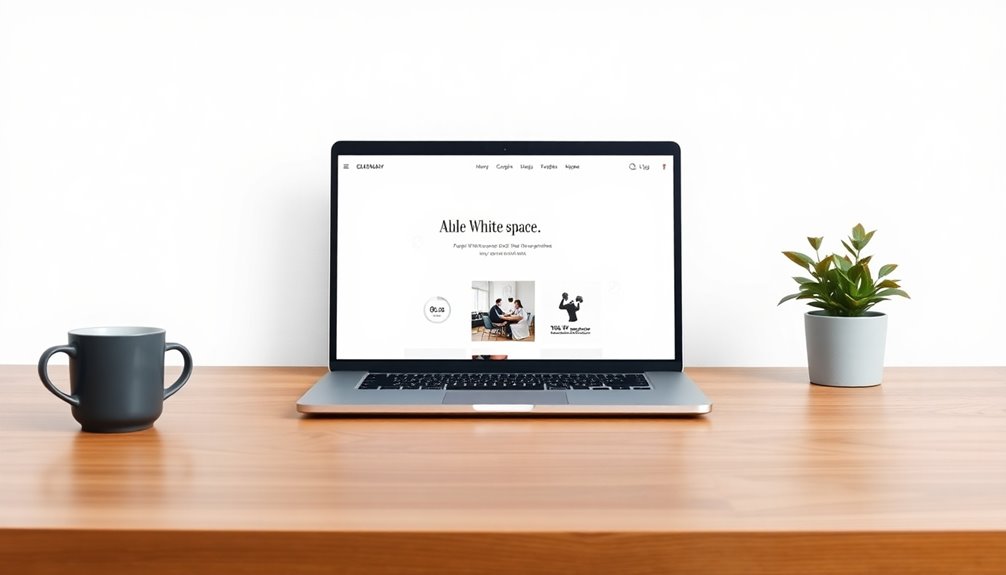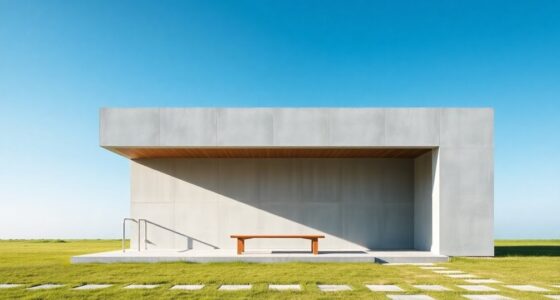To create a minimalist website design, start by defining your site's purpose, keeping your target audience in mind. Organize content logically and prioritize clarity through concise language. Choose a clean color scheme with a neutral base and a couple of accent colors for harmony. Optimize for speed by compressing images and minimizing HTTP requests. Finally, regularly review your design based on user feedback to refine and enhance the overall experience. There's more to explore on achieving the perfect minimalism.
Key Takeaways
- Clearly define the website's purpose to guide design choices and content relevance while targeting user needs.
- Organize content logically using a simple sitemap and concise presentations to enhance user navigation and experience.
- Choose a neutral base color complemented by one or two accent colors, ensuring sufficient contrast for readability.
- Optimize website speed by compressing images, minimizing HTTP requests, and enabling browser caching to enhance performance.
- Regularly review and refine design elements based on user feedback and current trends, focusing on clarity and functionality.
Defining Your Website's Purpose

When you clearly define your website's purpose, you set the foundation for effective design and content creation. Focusing on defining your website's purpose helps you prioritize essential elements, allowing for a minimalist approach that eliminates distractions.
Consider your target audience; understanding their needs and preferences is vital for aligning your site with user expectations. A well-articulated purpose guarantees that your content remains relevant and directly supports your business goals. Additionally, crafting a clear call to action will enhance user engagement, guiding visitors on what to do next. Regularly revisit your website's purpose to adapt to evolving user needs and market trends, ensuring your design remains effective and impactful. Furthermore, a strong brand identity correlates with customer loyalty, which reinforces the importance of a clear purpose in your website design.
Organizing Content Effectively

To create an effective minimalist website, you need to organize your content in a way that aligns with your site's purpose and user needs.
Start by defining your primary goals and creating a sitemap that outlines a simple structure for easy navigation.
Use a logical organization by grouping related information, enhancing user experience and comprehension.
Prioritize concise and effective content presentation; aim for brevity while ensuring your key messages shine.
This approach allows your content to breathe, using effective white space to avoid clutter.
Keep the hierarchy of your content clear, so users can quickly grasp the information they need.
Regularly review and update your content to maintain relevance and engagement, eliminating outdated material that detracts from the overall user experience. Additionally, consider using budget tracking tools to help manage content updates and resource allocation effectively.
Choosing a Clean Color Scheme

A well-organized content layout sets the stage for your website, but choosing a clean color scheme is just as essential to achieving a minimalist design. Start with a neutral base color like white or gray to create a timeless backdrop. Then, select one or two accent colors that adhere to color harmony principles to enhance your brand identity. Limit your color palette to three or four colors to avoid overwhelming users with visual noise. Maintain sufficient contrast between text and background to improve readability, aiming for a contrast ratio of at least 4.5:1 for normal text. Incorporating natural materials can also inspire a harmonious aesthetic in your design.
| Base Color | Accent Color 1 | Accent Color 2 |
|---|---|---|
| White | Blue | Green |
| Black | Red | Yellow |
| Gray | Teal | Orange |
Optimizing for Speed and Performance

While a visually appealing design is essential, optimizing your website for speed and performance can greatly enhance user experience.
Start by compressing images to reduce file sizes while maintaining high-quality visuals, aiming for load times under 3 seconds.
Next, minimize HTTP requests by combining CSS and JavaScript files, which can considerably decrease load times.
Utilize a Content Delivery Network (CDN) to serve your content from the closest server, improving access speed.
Enable browser caching to store frequently accessed resources locally, boosting load times for returning visitors.
Finally, minify code by removing unnecessary characters, spaces, and comments from your HTML, CSS, and JavaScript files.
This process can reduce file sizes by 20-30%, leading to a more effective website overall. Additionally, consistent maintenance, like regular cleaning of your website's resources, ensures optimal performance and user experience.
Reviewing and Refining Your Design

As you work to maintain a minimalist website, regularly reviewing and refining your design is essential for guaranteeing it aligns with your overall vision.
Focus on these key areas:
- Review design elements: Guarantee they promote clarity and functionality without clutter.
- Utilize user feedback: Analyze responses and analytics to identify improvement areas and enhance engagement.
- Audit layout: Confirm intuitive navigation and a clear hierarchy that highlights essential elements.
- Stay updated on best practices: Keep your site contemporary by following current design trends while avoiding unnecessary additions.
Additionally, incorporating high-quality content into your design can significantly enhance user experience and engagement.
Frequently Asked Questions
How Do You Create a Minimalist Website?
To create a minimalist website, start by defining your primary purpose.
Choose a limited color palette with one or two accent colors for visual harmony.
Prioritize white space in your layout to keep things clean and improve readability.
Organize your content using a logical grid system, establishing a clear visual hierarchy.
Finally, optimize performance by compressing images and minimizing requests, ensuring a fast-loading site that enhances user engagement.
How to Create a Website for Beginners Step by Step?
To create a website as a beginner, start by choosing a user-friendly website builder like Wix.
Define your site's purpose and target audience to guide your content. Gather high-quality images and text for essential pages like the homepage and About Us.
Keep the layout clean and navigation intuitive by limiting pages and menu items.
Finally, regularly update your site with fresh content and optimize for speed to enhance user experience.
How Do I Start a Web Design for Beginners?
Starting your web design journey can feel like standing at the edge of a vast ocean, ready to plunge into.
You'll want to pick a user-friendly website builder like Wix or Squarespace. Then, research competitors to find inspiration and essential features.
Gather high-quality content that showcases your brand, sketch out a sitemap to organize your thoughts, and focus on a clean layout.
Regularly update your site to keep it fresh and engaging!
What Is the Rule of Minimalist Design?
The rule of minimalist design is all about stripping away the non-essential elements.
You focus on what truly enhances user experience and functionality. Embrace a clean layout, using plenty of white space to improve readability and highlight key content.
Stick to a limited color palette, often neutrals with a few accent colors, and choose bold, sans-serif fonts for clear communication.
Conclusion
To sum up, creating a minimalist website design not only enhances user experience but also boosts engagement. Did you know that websites with simple designs can lead to a 60% increase in conversion rates? By focusing on your website's purpose, organizing content effectively, and optimizing for speed, you'll craft a clean and efficient site that resonates with visitors. So, embrace the minimalist approach and watch your online presence thrive!









